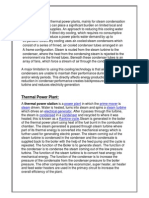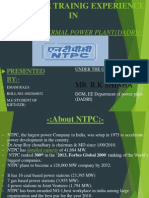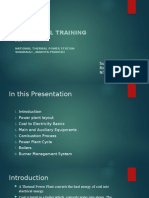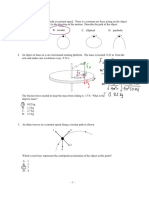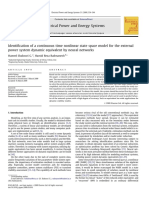Steam Power Plant
Steam Power Plant
Uploaded by
Karthikn AltocCopyright:
Available Formats
Steam Power Plant
Steam Power Plant
Uploaded by
Karthikn AltocCopyright
Available Formats
Share this document
Did you find this document useful?
Is this content inappropriate?
Copyright:
Available Formats
Steam Power Plant
Steam Power Plant
Uploaded by
Karthikn AltocCopyright:
Available Formats
POWER PLANT ENGINEERING
INTRODUCTION Power plays a greater role wherever man lives and works. Electricity is the only form of energy which is easy to produce, transport and easy to control. The types of power plants which is used to produce the electricity are thermal, nuclear, hydraulic, gas turbine and geothermal.
In the above said power plants, the thermal power plants generate more than 80% of the total electricity produced in the world. Fossil fuel like coal, fuel oil and natural gas are the energy sources and steam is the working fluid. Thermal power production cost in India is more when compared to nuclear power due to rise in oil prizes. Hydraulic power plants are essentially multi purposes. It is used for power generation as well as irrigation. Nuclear energy has enlarged the worlds power resources. The amount of energy released by burning one kilogram of uranium is equivalent to the energy obtained by burning 4500tonnes of high-grade coal. The renewable energy source like solar energy in India has ideal geographical situations. If the sunshine is bright for an average of 8hours/day, then the amount of heat equivalent is more than 200MW per square kilometer. In this unit, the various layouts of power plants are discussed. They are shown below as follows: 1. Steam or thermal power plant. 2. Hyde power plant. 3. Diesel power plant. 4. Magneto hydrodynarnic (MHD). 5. Nuclear and gas power plants.
POWER PLANT ENGINEERING
STEAM POWER PLANT
Introduction: Steam is an important medium for producing mechanical energy. A steam power plant continuously converts the energy stored in fossil fuels (coal, oil and natural gas). Steam has the advantage that it can be raised from water which is available in abundance. The steam power stations are very much suitable where coal is available in abundance. The pressure ranges from 10kg/cm2 to super critical pressure and temperature varies from 250C to 650C. Working Principle Steam or thermal power plant is using steam as working fluid. Steam is produced in a boiler using coal as fuel and used to drive the prime mover (Steam turbine).The heat energy is converted into mechanical energy by the steam turbine and that mechanical energy is used for generating power with the help of generator. The layout of the steam power plant consists of four main circuits as shown in below figure. The main circuits are given below as follows: 1. Coal and ash circuit. 2. Water and steam circuit. 3. Air and flue gas circuit. 4. Cooling water circuit.
POWER PLANT ENGINEERING 1. Coal and ash circuit: This circuit consists of coal storage, ash storage, coal handling and ash handling systems. Coal from mines is delivered by ships, rails or trucks to the power station. Coal received at coal yard. Coal is sized by crushers, breakers etc., the sized coal is stored in coal storage. From stock yard, the coal is transferred to the boiler furnace by means of conveyors, elevators etc. The coal is burnt in the boiler and ash is formed. Ash coming out of the furnace will be too hot, dusty and accompanied by poisonous gases. The ash is transferred to the ash storage. Generally the ash will be quenched to reduce the temperature and the dust content. The handling system consists of belt conveyors, screw conveyors etc. Coal from the storage yard is transferred to the boiler furnace by means of coal handling equipment as shown in below figure.
Ash resulting from the combustion of coal in the boiler furnace is removed to ash storage through ash handling. The Indian coal contains 30 to 40% of ash and a power plant of 100MW produces normally 20 to 25 tons of hot ash per hour. 2. Air and flue gas circuit: Air is taken from the atmosphere by the action of Forced Draft fan it is then passed to the air preheated; the dust from the air is removed by means of using air filter.
POWER PLANT ENGINEERING The air is preheated by the flue gases in the pre heater. This preheated air is supplied to the furnace to aid the combustion of fuel. Due to the combustion of fuel the flue gases are formed. The flue gases from the furnace pass over the boiler tubes and super heater tubes. Then the flue gases pass through economiser to heat the feed water. After that it passes through a dust collector. It is then exhausted to atmosphere through chimney. 3. Feed water and steam circuit: The steam generated in the boiler passes through super heater and is supplied to the steam turbine. Heat is transferred to the water by the burning of the coal. The steam is expanded in the steam turbine then passed to the condenser where it is condensed. The turbine drives generator to produce electric power. The condensate is heated in the HP and LP heaters using the steam tapped from different points of the turbine.
The feed water is passing through the economizer, where it is further heated by means of flue gases. Using the economizer, the feed water is heated by the feed water heaters and then it is fed into the boiler. Part of the steam and water are lost while passing through different components of the system. The expanded steam is then passed through the condenser. In the condenser, steam is condensed into water then re circulated. 4. Cooling water circuit: This circuit consists of circulating water pump, condenser, cooling water pumps and cooling tower. The exhaust steam from the turbine is condensed in the condenser. Adequate water supply is available from various sources like river or lake. In the condenser, the cold water is circulated to condense the steam into water. The steam is then condensed by losing its latent heat to the circulating the cold water. Hence the cold water gets heated.
POWER PLANT ENGINEERING The basic layout of the cooling water circuit is shown in below figure.
This hot water is then taken to a cooling tower. In cooling tower the water is sprayed in the form of droplets through nozzles. The atmospheric air enters the cooling tower from the openings provided at the bottom of the tower. This cold water is again circulated through the pump, condenser and the cooling. Some amount of water may be lost during circulation. Hence make up water is added to the pond by means of a pump. Characteristics of steam power plant: The characteristics of the steam power plant or thermal power plant is given below as follows: 1. Low cost as compared with hydro power plant. 2. High efficiency. 3. Reduced water requirement. 4. Higher reliability and availability. 5. Reduced environmental impact in terms of air pollution. Advantages of steam power plant: The advantages of the steam power plant or the thermal power plant is shown in below figure: 1. The power production does not depend on nature mercy. 2. Initial investment is low. 5
POWER PLANT ENGINEERING 3. The power plant can be located near load center, so the transmission cost and losses are considerably reduced. 4. The time requirement for construction and commissioning of thermal power plant require less period of time. 5. Life of plant is more (25-30 years ) compared to Diesel plant (2-5 years) 6. Repair and maintenance cost is low when compared to diesel plant. 7. Suitable for varying load conditions. 8. No radioactive harmful wastes are produced 9. Unskilled operators can operate the plant. 10. The power generation does not depend on the water storage. 11. There are no transmission losses, as they are located near load centers. Disadvantages of steam power plant: The disadvantage of the steam power plant is given below as follows: 1. As compared with hydro-electric power plant, life and efficiency are less. 2. Transportation of fuel is a major problem in this type of power plant. 3. Power generation cost is considerably high when compared to hydro-electric plant. 4. Air pollution is the major problem calling for additional investment. 5. It cannot be used as peak load plant. 6. Cooling water required is more. 7. Space required is more. 8. Storage required for the fuel is more. 9. Ash handling is a big problem 6. The coal (fuel) needed may be exhausted by gradual use. 7. Less efficient than diesel plants. 8. Starting up and bringing into service takes more time. 9. Not economical in areas which are remote from coal fields. 10. Manpower required is more. 11. For large units, the capital cost is more.
You might also like
- Thermal Power Plant Project ReportDocument63 pagesThermal Power Plant Project Reportasutoshjena28173% (26)
- Report On Jenco Thermal Power PlantDocument18 pagesReport On Jenco Thermal Power PlantMuhammadAbbasJafri100% (1)
- 5V From Portable Wind TurbineDocument7 pages5V From Portable Wind TurbineAl-hafiz JamilNo ratings yet
- APICE - Manuale TERP3Document56 pagesAPICE - Manuale TERP3GiuseppeProiettiNo ratings yet
- Introduction To Electrical Power Systems: by K.rajendraDocument101 pagesIntroduction To Electrical Power Systems: by K.rajendrak rajendraNo ratings yet
- Basic Civil and Mechanical Engineering Unit III Classification of Power PlantsDocument21 pagesBasic Civil and Mechanical Engineering Unit III Classification of Power PlantsSiman NapstervkkNo ratings yet
- Dry Cooling Systems1.2Document40 pagesDry Cooling Systems1.2paragmishra1986No ratings yet
- Steam Power PlantDocument20 pagesSteam Power PlantSiddi Sampath Kumar Reddy100% (1)
- PP 9th Meeting GENERATING STATIONS Thermal Power PlantDocument5 pagesPP 9th Meeting GENERATING STATIONS Thermal Power PlantJohn Kenneth LoricoNo ratings yet
- Thermal Power PlantsDocument24 pagesThermal Power Plantslakshmigsr6610100% (1)
- Steam Power PlantDocument7 pagesSteam Power Plantsuganya100% (1)
- 1.1.power Plant LayoutDocument5 pages1.1.power Plant LayoutBALAMBAL R100% (1)
- Thermal Power Plant - EeDocument20 pagesThermal Power Plant - EePrabhat Chandra100% (1)
- Physics 4.Document5 pagesPhysics 4.SOLAIMANNo ratings yet
- Steam Power Plant (PLTU)Document5 pagesSteam Power Plant (PLTU)Aldi Erzanuari100% (1)
- Report #1: Alternating-Current Project: Steam-Electric Power PlantDocument41 pagesReport #1: Alternating-Current Project: Steam-Electric Power PlantKian Tecson100% (1)
- Power Plant Engineering MTPP-1Document13 pagesPower Plant Engineering MTPP-1devendra pratapNo ratings yet
- Selections of Powerplants LocationDocument4 pagesSelections of Powerplants LocationMostafa GadelrabNo ratings yet
- Unit - 1Document19 pagesUnit - 1thunderchad2004No ratings yet
- Rohini 86450143586Document8 pagesRohini 86450143586Anksupriya BanerjeeNo ratings yet
- Thermal Power Plants (Steam Power Plants) : Instructor: Engr. Intisar Ali SajjadDocument51 pagesThermal Power Plants (Steam Power Plants) : Instructor: Engr. Intisar Ali SajjadVishal PatelNo ratings yet
- Coal Fired Thermal Power Plant What Is A Thermal Power Plant?Document6 pagesCoal Fired Thermal Power Plant What Is A Thermal Power Plant?carlo manabatNo ratings yet
- Thermal EngineeringDocument10 pagesThermal Engineeringlokeshdhangar842No ratings yet
- Me Lab 3Document27 pagesMe Lab 3Jerome Vega AndesNo ratings yet
- CoalDocument48 pagesCoallekoringoeNo ratings yet
- Thermal Power PlantDocument6 pagesThermal Power PlantMasha Allah QasimiNo ratings yet
- Industrial Visit Report On Siddhirganj 210MW Thermal Power StationDocument14 pagesIndustrial Visit Report On Siddhirganj 210MW Thermal Power StationSaibNo ratings yet
- Thermal Power Plant Diagram All You Need To Know About ItDocument7 pagesThermal Power Plant Diagram All You Need To Know About Itngoc hoangNo ratings yet
- UNIT 1 Thermal Power PlantsDocument108 pagesUNIT 1 Thermal Power PlantsdgatnittNo ratings yet
- General Layout of A Thermal Power PlantDocument87 pagesGeneral Layout of A Thermal Power PlantHarjith Vaibav100% (1)
- Thermal Power PlantDocument35 pagesThermal Power PlantAngelaa DassNo ratings yet
- Thermal Power PlantDocument16 pagesThermal Power PlantmudarNo ratings yet
- EXP-1 Steam Power PlantDocument7 pagesEXP-1 Steam Power PlantsejalNo ratings yet
- Project ReportDocument103 pagesProject ReportSeth CamachoNo ratings yet
- TpsDocument22 pagesTpskavya sagarNo ratings yet
- Report of Electrical Wiring: Submitted To: Sir Urooj Uz ZafarDocument21 pagesReport of Electrical Wiring: Submitted To: Sir Urooj Uz Zafarshrawan0908No ratings yet
- Introduction To CFPPDocument34 pagesIntroduction To CFPPVenkat CherukuriNo ratings yet
- Thermal Power Plant: Gaini Zail Singh Punjab Technical University Campus (Bathinda)Document30 pagesThermal Power Plant: Gaini Zail Singh Punjab Technical University Campus (Bathinda)Sriram ramsNo ratings yet
- Steam Powerplant ReportDocument14 pagesSteam Powerplant ReportAngeli Cascaño JoseNo ratings yet
- Steam Power Plant: Boiler CondenserDocument4 pagesSteam Power Plant: Boiler Condenserwajahat aliNo ratings yet
- Steam Power PlantDocument3 pagesSteam Power PlantRima SadekNo ratings yet
- Table of Content: Page Number 1 3 2 Parts 6 3 Function Diagram 8 4 Function 9 5 Advantages 18 6 Disadvantages 20Document20 pagesTable of Content: Page Number 1 3 2 Parts 6 3 Function Diagram 8 4 Function 9 5 Advantages 18 6 Disadvantages 20Utsav ShuklaNo ratings yet
- Power Plant Instrumentation Class Notes For Dr. Sanjeev Kumar Raghuwanshi Electronics Engineering Department IIT (ISM) DhanbadDocument55 pagesPower Plant Instrumentation Class Notes For Dr. Sanjeev Kumar Raghuwanshi Electronics Engineering Department IIT (ISM) DhanbadviratNo ratings yet
- Gajendra KumarDocument23 pagesGajendra KumarGAJENDRA KUMARNo ratings yet
- LayoutDocument3 pagesLayoutashok pradhanNo ratings yet
- Thermal Power PlantDocument29 pagesThermal Power PlantSiri Venni100% (1)
- Thermal Power Plant - Diagram, Layout, Working & ConstructionDocument25 pagesThermal Power Plant - Diagram, Layout, Working & ConstructionACME NKSTPPNo ratings yet
- Industrial Training Report ON C & I Maintenance Division Unit-8 AT Panipat Thermal Power StationDocument27 pagesIndustrial Training Report ON C & I Maintenance Division Unit-8 AT Panipat Thermal Power StationAbhishek AroraNo ratings yet
- Ukai Thermal Power Plant-Eman Refai Abdelkhaliq-Sec 3Document13 pagesUkai Thermal Power Plant-Eman Refai Abdelkhaliq-Sec 3eman.refai13lcsNo ratings yet
- NTPCDocument33 pagesNTPCSubodh DuhanNo ratings yet
- Generation of Electric PowerDocument108 pagesGeneration of Electric Powermausam sharma100% (1)
- Industrial Training Report NTPCDocument30 pagesIndustrial Training Report NTPCTabish KhanNo ratings yet
- Ppe NotesDocument51 pagesPpe NotesCharan PrasadNo ratings yet
- Industrial Training AT: Submitted By: Rishikesh (11-1-6-002) NIT, SilcharDocument26 pagesIndustrial Training AT: Submitted By: Rishikesh (11-1-6-002) NIT, SilcharRakesh Roshan KeshriNo ratings yet
- Coal-Based Electricity ProductionDocument11 pagesCoal-Based Electricity ProductionkirannainwalNo ratings yet
- SIREreport 118ee0297Document13 pagesSIREreport 118ee0297Bhabani sankar KishanNo ratings yet
- Jagan Steam Power PlantDocument101 pagesJagan Steam Power PlantMahender VangalaNo ratings yet
- Power Plant EngineeringDocument74 pagesPower Plant EngineeringPranesh Ka100% (1)
- Power Plant Training ReportDocument26 pagesPower Plant Training ReportAnil YadavNo ratings yet
- Jaipur: Vivekananda Institute of TechnologyDocument29 pagesJaipur: Vivekananda Institute of TechnologyAashish SangwanNo ratings yet
- Mechanics of the Household: A Course of Study Devoted to Domestic Machinery and Household Mechanical AppliancesFrom EverandMechanics of the Household: A Course of Study Devoted to Domestic Machinery and Household Mechanical AppliancesNo ratings yet
- Mechatronics UNIV LAB QPDocument4 pagesMechatronics UNIV LAB QPKarthikn AltocNo ratings yet
- Dom 16 MarksDocument2 pagesDom 16 MarksKarthikn AltocNo ratings yet
- Eg - Proj - of ST - Lines PDFDocument22 pagesEg - Proj - of ST - Lines PDFKarthikn AltocNo ratings yet
- Hydraulic CircuitsDocument30 pagesHydraulic CircuitsKarthikn Altoc100% (3)
- DDC 232Document35 pagesDDC 232Gazza TNo ratings yet
- Total Station: Parts, Functions and Setting-Up ProceduresDocument15 pagesTotal Station: Parts, Functions and Setting-Up ProceduresKhiel Yumul100% (1)
- Citel 2CP 202302en Pl24-Cat6Document1 pageCitel 2CP 202302en Pl24-Cat6vish2008 anandNo ratings yet
- Adsorption, Adsorbant and AdsorbateDocument6 pagesAdsorption, Adsorbant and AdsorbateVijay kumarNo ratings yet
- Safety SuppliesDocument23 pagesSafety SuppliesjobsitesupplycoNo ratings yet
- Muntinlupa Ordinance - Underground SystemDocument6 pagesMuntinlupa Ordinance - Underground Systemglenn anayronNo ratings yet
- Grade 6 q2 Mathematics LasDocument151 pagesGrade 6 q2 Mathematics LasYZA BAYANo ratings yet
- FGSR Example Gas Emergency Escape PlanDocument36 pagesFGSR Example Gas Emergency Escape PlanAnonymous GfPSYi4nNo ratings yet
- 5.1 Contractor HSE Capability AssessmentDocument4 pages5.1 Contractor HSE Capability AssessmentyasirNo ratings yet
- Installation Guide Jeehell FMGSDocument23 pagesInstallation Guide Jeehell FMGScaptainhenrychenNo ratings yet
- How Products Are Made - Vol 6 (2001)Document476 pagesHow Products Are Made - Vol 6 (2001)onslaughtilusNo ratings yet
- Bài Tập Tổng Hợp Cho Hsg (Tặng Kèm- No Key)Document58 pagesBài Tập Tổng Hợp Cho Hsg (Tặng Kèm- No Key)nguyenlien.c3doicanNo ratings yet
- Kk-080725 - The Dark KnightDocument1 pageKk-080725 - The Dark KnightkatehasablogNo ratings yet
- A Simple Method For Noninvasive Estimation of Pulmonary Vascular ResistanceDocument7 pagesA Simple Method For Noninvasive Estimation of Pulmonary Vascular ResistanceJorge KlyverNo ratings yet
- LU200 Data Sheet Aug2014 Final PRINT 27augDocument2 pagesLU200 Data Sheet Aug2014 Final PRINT 27aug송민호No ratings yet
- Energies: Thermal Assessment of Power Cables and Impacts On Cable Current Rating: An OverviewDocument38 pagesEnergies: Thermal Assessment of Power Cables and Impacts On Cable Current Rating: An OverviewPratikNo ratings yet
- DL T 5174Document191 pagesDL T 5174ananizisikimNo ratings yet
- Circular Motion Review Key PDFDocument21 pagesCircular Motion Review Key PDFKen HueyNo ratings yet
- Brahimi Et Al 2018 ESR Tuareg Shield Terranes Revisited & Extended Towards N Gondwana Margin Magnetic & GravimetricDocument28 pagesBrahimi Et Al 2018 ESR Tuareg Shield Terranes Revisited & Extended Towards N Gondwana Margin Magnetic & GravimetricLydia LnzNo ratings yet
- Example 4-Single Room With Ver-MohsinDocument7 pagesExample 4-Single Room With Ver-MohsinkhanclipcollectionNo ratings yet
- Enciclopedia de Sistemas y CibernéticaDocument18 pagesEnciclopedia de Sistemas y CibernéticaEduardo TejeDaNo ratings yet
- Dried Golden BerriesDocument5 pagesDried Golden Berriesmarcela camargoNo ratings yet
- Drager Savina 1.n Operating Ma PDFDocument144 pagesDrager Savina 1.n Operating Ma PDFAhmerShehzadNo ratings yet
- CD-35655bb Trocola GiratoriaDocument82 pagesCD-35655bb Trocola GiratoriaJESUSCALVILLONo ratings yet
- 1 (Done)Document19 pages1 (Done)Santu PatraNo ratings yet
- Analysis and Design of Discrete Part Production Line PDFDocument288 pagesAnalysis and Design of Discrete Part Production Line PDFKHAMALUDIN KHAMALUDINNo ratings yet
- Expt 12-Stepper Motor Control Using 8051Document20 pagesExpt 12-Stepper Motor Control Using 8051nava krishnanNo ratings yet
- Electrical Power and Energy Systems: Hamed Shakouri G., Hamid Reza RadmaneshDocument11 pagesElectrical Power and Energy Systems: Hamed Shakouri G., Hamid Reza RadmaneshMahra Rizvani PratamaNo ratings yet







